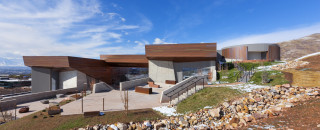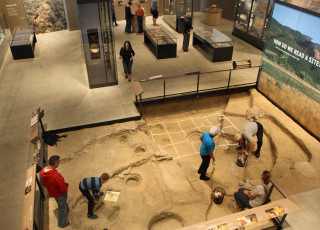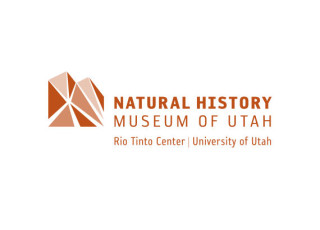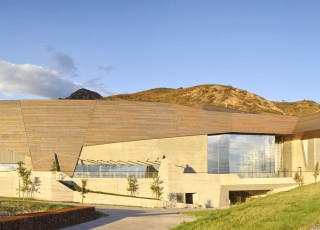Come Discover the Natural History Museum of Utah at Rio Tinto Center
Salt Lake City, UT – The Natural History Museum of Utah, located at the University of Utah, is basking in a stunning new home along the foothills of the Rocky Mountains. Dedicated in November of 2011, more than 4,000 visitors came to see the new facilities on the very first weekend. Recognized as an architectural jewel, both inside and out, the building, named the Rio Tinto Center as a result of a naming-level donation by Kennecott Utah Copper/Rio Tinto, was inspired by Utah's diverse landscapes and showcases a breath-taking view of the expansive Salt Lake Valley. Funded by both public and private partnerships, the Museum has already become a primary tourist destination for children and families, students, natural scientists and visitors to the region from around the world. The new Museum also provides advanced research facilities and has become an established venue for undergraduate and graduate education at the University of Utah.
“We feel Utah residents will be very proud of our new home, which is the product of the work of literally every community in the state and experts from around the world,” said Sarah George, executive director of The Natural History Museum of Utah. “I believe we now offer one of the nation’s great new cultural buildings in which architecture and exhibition content serve and advance science and education while respecting their natural surroundings. We look forward to many years of telling the exciting and important stories of the natural world.”
In fact, for over four decades, the Natural History Museum of Utah has connected Utah residents and tourists alike with the natural wonders and native cultures that define Utah. As an active research institution with a remarkable and growing collection of more than 1.6 million specimens and objects, the Museum is an extraordinary cultural and educational asset for understanding the world. Over the years, the Museum has garnered the respect and affection of visitors, state and local leaders, scientists and museum professionals through programs of sustained excellence in the areas of public education, scientific research, collections preservation and environmental stewardship.
Rio Tinto Center – Design
The extraordinary new 163,000-square-foot Rio Tinto Center, clad in 42,000 square feet of copper, occupies a prominent place at the edge of Salt Lake City and the University of Utah. The facility blends seamlessly into the foothills of the Rocky Mountains, the angles of the roof rising and falling with the slope of the foothills in the background. The design reflects the Museum’s mission to illuminate the natural world through scientific inquiry, educational outreach, mutual cultural experience and human engagement of the past, present and future of the region and the world.
Designed by Todd Schliemann of Ennead Architects, the Museum’s new home overlooks the Salt Lake Valley from its stunning 17-acre site. Leading members of the project team, include Mr. Schliemann, Don Weinreich of Ennead Architects, as well as David Brems and John Branson of Salt Lake City’s GSBS Architects.
Inspired by the region's natural landscape of rock, soil, minerals and vegetation, the Rio Tinto Center rests on a series of terraces that step up the hill and lie along the contours of the site with minimal disruption to the adjacent natural landscape. The new building is located above the shoreline of ancient Lake Bonneville, with the Bonneville Shoreline Trail passing through the property, and provides breathtaking views of the Wasatch Front. Respect for the natural world and human engagement in it is underscored by the design’s “green” initiatives.
With the artful integration of sound principles of sustainability, the design of the Natural History Museum of Utah will play a seminal role in enhancing the public's understanding of the earth's resources and systems and be a model for responsible and environmentally sensitive development. By incorporating the use of recycled materials, local resources, photo voltaic energy, radiant cooling and the implementation of an extensive storm water catchment and management system, the Natural History Museum of Utah is seeking LEED Gold certification, which would make it one of only 18 buildings in Salt Lake City with that distinction.
Inside, the building is divided by a sixty-foot-high central public space, The Canyon, which is the centerpiece of the Museum’s interior. One wing of the stunning new Museum contains long-needed spaces dedicated to the objective understanding of our world – research laboratories, conservation labs, collection storage and administration. The other wing houses public spaces with exhibitions dedicated to the subjective or interpretive aspects of our world so visitors can explore the delicate balance of life on earth and its natural history – galleries and spaces in which to present, interpret and study the Museum’s extraordinary collection of artifacts and exhibits.
Museum Exhibitions
The Natural History Museum of Utah houses the state’s world-class collections in new exhibitions designed by Ralph Appelbaum Associates (RAA) and offers more than 41,300 square feet of gallery and education space, including The Canyon where some Museum theater pieces will be performed. By embracing the tools of modern architecture, exhibition design and media, the re-envisioned Museum presents a fresh, fascinating and immersive journey through the natural formation of life and land around Salt Lake City and throughout the state of Utah.
The Museum’s collections form the basis for all of the Museum's educational functions, from public exhibits and programming to scholarly research and publication. Its systematic collections in the fields of earth sciences, biology and anthropology rank among the largest and most comprehensive in the western United States. While emphasizing the Great Basin and Colorado Plateau, they also include material from throughout the world. Ongoing development of these collections is directed toward strengthening their comprehensive regional coverage and increasing their significance and accessibility to all communities.
The new Museum's exhibitions tap its vast collections in new ways and aim to put more of Utah's treasures on display. This is done in a set of interdisciplinary galleries that explore the diverse ways in which we understand our world. The selection of objects necessitated a careful analysis of the Museum’s existing collections – some of which had never been seen by the public – and a convergence of traditional perspectives to tell a more nuanced story. Nine dedicated, thematic exhibition galleries explore the Sky, Native Voices, Life, Land, First Peoples, Lake (Great Salt Lake), Past Worlds, Our Backyard and Utah's Futures. Each gallery draws from several scientific disciplines and collections as well as from the humanities.
The Rio Tinto Center will offer several free areas in the Museum building: The Canyon, boasting expansive views of the valley; the Museum Store; and the Museum Café, with indoor/outdoor seating and access to the University of Utah’s Wi-Fi network.
About the Natural History Museum of Utah
The Natural History Museum of Utah is one of the leading scientific research and cultural institutions in the country. Established in 1963, the Museum‘s collections contain over 1.6 million objects and offers innovative exhibitions and educational programs to thousands of residents and visitors each year, including traveling and permanent exhibits, special events and other programs. With an expected attendance of 180,000 visitors a year, the Museum also offers a variety of outreach programs to communities and schools throughout Utah, reaching every school district in the state annually. The Museum has an active science program with more than 30 scientists and 10 field exhibitions each year.
Press contacts and links
-
Press Contact
Beth Mitchell



